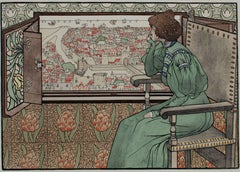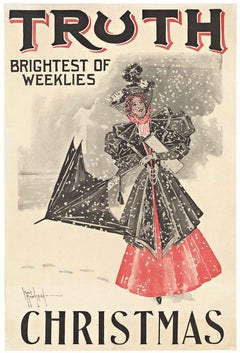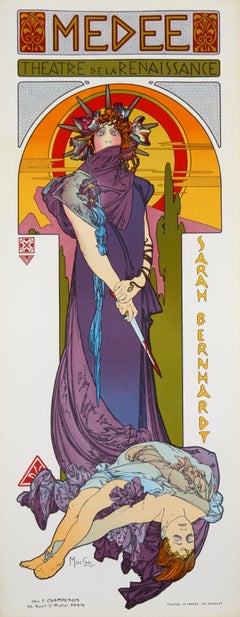Gustave Max Stevens Art
to
1
1
1
1
1
1
Overall Height
to
Overall Width
to
2
2
2
1
1
1
2
2
6,886
3,210
2,514
1,217
2
Artist: Gustave Max Stevens
"Solveig L'Estampe Moderne I, " Original Color Lithograph by Gustave-Max Stevens
By Gustave-Max Stevens
Located in Milwaukee, WI
"Solveig L'Estampe Moderne I" is an original color lithograph by Gustav Max Stevens, signed lower right in the stone. It depicts a woman (Solveig) in a green dress looking out a wind...
Category
1890s Art Nouveau Gustave Max Stevens Art
Materials
Lithograph
Solveig - Original litograph (1897/98)
By Gustave-Max Stevens
Located in Paris, FR
Gustave-Max Stevens
Solveig
Original litograph
Platesigned
1897/98
Printed on paper Vélin
Size 40 x 31 cm (c. 16 x 12")
INFORMATION : Published ...
Category
1890s Art Nouveau Gustave Max Stevens Art
Materials
Lithograph
Related Items
Original vintage poster "Truth" weekly magazine art nouveau lithograph
Located in Spokane, WA
Original vintage.poster: TRUTH CHRISTMAS. NOTE that this is the turn of the century original poster and is Not a magazine cover. The poster for a gossip magazine focusing on New...
Category
1890s Art Nouveau Gustave Max Stevens Art
Materials
Lithograph
H 20.5 in W 13.5 in D 0.05 in
Medee - Sarah Bernhardt (after) Alphonse Mucha, 1969
By Alphonse Mucha
Located in New York, NY
These beautiful and colorful lithographic posters were hand reproduced by the Mourlot Studio's Master Printer Henri Deschamps in 1969. They are not to be mistaken with later cheap di...
Category
1960s Art Nouveau Gustave Max Stevens Art
Materials
Lithograph
Original Kola Marque, 1895 vintage French liquor poster by Jules Cheret
By Jules Chéret
Located in Spokane, WA
Original stone lithograph KOLA MARQUE, created by the artist Jules Cheret in 1895. Size: 16" x 23.5". Professional acid free archival linen backed and ready to frame. Full boarders. Printer: Chaix. Jules Cheret is known as the father of the poster helping bring color printing to the world.
Kola Marque. Tonique et Aperitif. Stimule forces physiques et intellectuelles. It indicates that if you drink this it helps give you physical and intellectual stimulus. In addition, it is served in all the local cafes and restaurants. I haven't found a breakdown of what 'special' ingredients in this liquor would make you feel and think so much better.
Condition. This 1895 poster...
Category
1890s Art Nouveau Gustave Max Stevens Art
Materials
Lithograph
H 23.5 in W 16 in D 0.04 in
"Quinquina Dubonnet" Original Jules Cheret Maitre de l'Affiche
By Jules Chéret
Located in Hinsdale, IL
CHERET, JULES
(1836 - 1932)
"Quinquina Dubonnet"
Original lithograph from “Les Maitres de L’Affiche” series
Printed by Imprimerie Chaix, Paris
Bearing MDL stamp lower right, from issue #28, 1898. Plate #109
Unframed Size: 11 3/8 x 15 3/4”
The “Les Maitres de l’Affiche” series was offered as a subscription series to collectors every month for 60 months, from December 1895 through November 1900. The “Maitres de l’Affiche,” were issued as separate numbered sheets, referred to as “plates”. They were numbered, with the printers name “Imprimerie Chaix,” in the margin at the bottom left hand corner, “PL.1” to “PL.240.” In the margin at the bottom right hand corner of each, is a blind
embossed stamp from a design of Cheret’s. The smaller format and the fact the “Maitres” were a paid subscription series, allowed Imprimerie Chaix to use the latest state of the art printing techniques, not normally used in the large format posters due to cost. A very high quality of paper was used, where as the large format posters were printed on lesser quality newsprint, due to cost and a short expected life span. This explains why the quality of the printing, in the “Maitres de l’Affiche,” usually far exceeds that of their larger counterparts.
“The Dubonnet poster...
Category
1890s Art Nouveau Gustave Max Stevens Art
Materials
Lithograph
H 17.5 in W 14.5 in D 0.5 in
Original Pointe de Penmarch vintage French travel poster
By ALO (Charles Jean Hallo)
Located in Spokane, WA
Original poster: Pointe de Penmarch (Finistere). Circuit Automobile au Depart de Quimper. Artist: ALO, (Charles Hallo) 1884-1969. Archival linen backed and ready to frame. Stone lithograph printed in 1926. Rare travel poster.
The poster is in very good shape. The right-hand border does have a mark on the outside edge as shown in the images. Minimal wear for a used poster...
Category
1920s Art Nouveau Gustave Max Stevens Art
Materials
Lithograph
H 41 in W 29.25 in D 0.05 in
Original 1910 Officiel Paris Spectacles vintage poster for theater performances
Located in Spokane, WA
Linen backed original of the official event spectacles of Paris, promoting Moulin Rouge, Salome, Musee Grevin, Sarah-Rita, Madame Butterfly, Carmen, La Vie de Boheme. Orignial in ex...
Category
1910s Art Nouveau Gustave Max Stevens Art
Materials
Lithograph
H 39 in W 27 in D 0.05 in
"Grande Tuilerie d’Ivry" from Les Maitres de l'Affiche
By Alexandre Charpentier
Located in Hinsdale, IL
CHARPENTIER, ALEX
(1856 -1909)
"Grande Tuilerie d’Ivry"
Original lithograph from "Les Maitres de L'Affiche" series
Printed by Imprimerie Chaix, Paris
Bearing MDL stamp lower right, issue # 33, 1898. Plate #131
Unframed Size: 11 3/8 x 15 3/4”The
"Les Maitres de l'Affiche" series was offered as a subscription series to collectors every month for 60 months, from December 1895 through November 1900. The "Maitres de l'Affiche," were issued as separate numbered sheets, referred to as "plates". They were numbered, with the printers name "Imprimerie Chaix," in the margin at the bottom left hand corner, "PL.1" to "PL.240." In the margin at the bottom right hand corner of each, is a blind embossed stamp from a design of Cheret's. The smaller format and the fact the "Maitres" were a paid subscription series, allowed Imprimerie Chaix to use the latest state of the art printing techniques, not normally used in the large format posters due to cost. A very high quality of paper was used, where as the large format posters were printed on lesser quality newsprint, due to cost and a short expected life span. This explains why the quality of the printing, in the "Maitres de l'Affiche," usually far exceeds that of their larger counterparts. The text reads "Great Tileworks of Ivry, founded in 1854, Ivry-Port near Paris; the largest ceramics factory in the world for building, industry and art productions; Emille Muller stoneware; execution of works by masters of statuary; architectural facings; decorative sculpture; showroom and salesroom, 3 rue Halevy; the only tile able to bear the names Muller and Ivry; (tiles) guaranteed against frost" Given the commission for an extremely text heavy poster, the artist executes a masterful design. The angelic young boy holds the wares of this famous ceramics factory, against an abstract background awash in organic green hues. The handling of the immense text that flows from top to bottom in every available space shows great artistic skill, as the overall beauty of the design is intact. In 1989 the Metropolitan Museum of art acquired a stoneware plaque...
Category
1890s Art Nouveau Gustave Max Stevens Art
Materials
Lithograph
H 20 in W 16 in D 1 in
Original Bains de Mer de la Manche - Granville vintage Chemin de Fer poster
By Georges Meunier
Located in Spokane, WA
Original Bains de Mer de la Manche vintage poster. Artist Georges Meunier. Archival linen backed in good condition, ready to frame. Printer: Chaix ...
Category
1920s Art Nouveau Gustave Max Stevens Art
Materials
Lithograph
H 40 in W 28.75 in D 0.05 in
"Hippodrome des Art", Maitre de l'affiche lithograph
By François Duyck
Located in Hinsdale, IL
DUYCK, EDOUARD
(1872 -1897)
CRESPIN, ADOLPH
(1859 –1944)
"Hippodrome des Art"
Original lithograph from "Les Maitres de L'Affiche" series
Printed by Imprimerie Chaix, Paris
Bearing MDL stamp lower right, from issue #6, 1894. Plate #28
Unframed Size:11 3/8 x 15 3/4”
The "Les Maitres de l'Affiche" series was offered as a subscription series to collectors every month for 60 months, from December 1895 through November 1900. The "Maitres de l'Affiche," were issued as separate numbered sheets, referred to as "plates". They were numbered, with the printers name "Imprimerie Chaix," in the margin at the bottom left hand corner, "PL.1" to "PL.240." In the margin at the bottom right hand corner of each, is a blind embossed stamp from a design of Cheret's. The smaller format and the fact the "Maitres" were a paid subscription series, allowed Imprimerie Chaix to use the latest state of the art printing techniques, not normally used in the large format posters due to cost. A very high quality of paper was used, where as the large format posters were printed on lesser quality newsprint, due to cost and a short expected life span. This explains why the quality of the printing, in the "Maitres de l'Affiche," usually far exceeds that of their larger counterparts. "...Posters were created by the team of Duyck & Crespin, whose close collaborative efforts garnered them the nickname 'the Siamese twins.' Between their first joint attempt at poster-making in 1885-1886 and Duyck's death in 1897, the duo produced a large corpus of works... as well as set designs and costumes for the theatre " (Brussels p.76) This is a Belgian poster for the Ferme de Frahinfaz, on the Hippodrome des Art road near Spa. "Accommodations for riders and pedestrians. Fork and knife lunches, fresh milk, real "Faro" beer from Brussels and English beers"
Category
1890s Art Nouveau Gustave Max Stevens Art
Materials
Lithograph
Original Gustave Rouquier Bijouterie - jewelry art nouveau vintage poster
By Charles Naillod
Located in Spokane, WA
Original turn of the century French poster: Gustave Rouquier turn of the century stone lithograph for jewelry. Artist: Charles Naillod. Size: 47" x 63". "The most important choice in jewelry, watches, and goldsmith objects". This antique art nouveau authentic vintage poster...
Category
Early 1900s Art Nouveau Gustave Max Stevens Art
Materials
Lithograph
H 63 in W 47 in D 0.05 in
Hamlet - Theatre Sarah Bernhardt (after) Alphonse Mucha, 1969
By Alphonse Mucha
Located in New York, NY
These beautiful and colorful lithographic posters were hand reproduced by the Mourlot Studio's Master Printer Henri Deschamps in 1969. They are not to be mistaken with later cheap di...
Category
1960s Art Nouveau Gustave Max Stevens Art
Materials
Lithograph
Cercle Artistique de Schaerbeek
By Georges Henri Privat-Livemont
Located in West Hollywood, CA
The gallery is opening its private collection of art nouveau and art deco paintings, lithographs and antiques for the first time in more than twenty years.
Presenting an original li...
Category
1890s Art Nouveau Gustave Max Stevens Art
Materials
Lithograph
Previously Available Items
The Twelve Princesses
By Gustave-Max Stevens
Located in New Orleans, LA
The greatest triumph of the artist’s career, this extraordinary and monumental oil on canvas by Gustave-Max Stevens perfectly represents the highly detailed compositions and richly hued palettes championed by the Pre-Raphaelite Brotherhood. The composition’s larger-than-life-size, brilliant coloring and myriad details enhance the drama of its subject, the Grimm Brothers’ fairy tale, The Twelve Princesses. The artist exhibited this work extensively, including at the 1901 Paris Salon, testifying to both the artist’s regard for the work and its exceptional quality.
Monumental in subject, style and size, it is clear that the artist himself knew that The Twelve Princesses was his masterpiece, and he took every opportunity to show it publicly. It was first shown shortly after its creation at an exhibition of the artist’s work at the Cercle Artistique et Littéraire in Brussels in 1899 and then at the Salon d’Art Idéaliste in Brussels. It was then accepted into the prestigious Paris Salon of 1901, the annual exhibition where artists showcased only the very best examples of their work. The artist also exhibited it with Sächsischer Kunstverein (Saxon Art Association) in Dresden in 1900, the Antwerp Triennial Salon of 1901 and the Salon des Beaux-Arts d’Ostende of 1907. Additionally, Stevens kept The Twelve Princesses in his own personal collection for the entirety of his life, and it descended within his family — a testimony to the artist’s particular attachment to this work.
The fairy tale The Twelve Princesses, or The Shoes That Were Danced to Pieces, tells the story of twelve sisters who are kept locked up in their bedroom every night by their father, the king. Despite this, the king finds his daughters’ shoes “danced to pieces” every morning when he releases them. He presents a challenge to his kingdom: “Whoever could discover where they went dancing each night could choose one of them for his wife and become king after his death.” After many before him fail, a man accepts the challenge and, with the help of an invisibility cloak, discovers the sisters travel to a magical underground realm where they attend a lavish ball every evening.
Stevens chooses to depict the moment of the sisters' escape. They adorn themselves in their finest gowns and jewels, with each princess dressed more extravagantly than the last. His approach to the painting is meticulous yet romantic, and the entire composition is a feast for the senses. The long, graceful silhouettes of the princesses occupy the entirety of the colossal canvas, and the artist revels in a painstaking depiction of detail for each and every figure. Strongly-patterned, iridescent fabrics combine with lush jewel tones to create a highly expressive aesthetic that brings a sense of realism to the mythical narrative.
Stevens captures the princesses with the precise detail and symbolism that were tenets of the Pre-Raphaelite Brotherhood. They are shown standing before a window barred with iron, emphasizing the wonder of their nightly escape. The central figure gazes into a mirror, serving not as a symbol of vanity, but rather representing the ephemeral, alternate world they are about to enter. The mirror holds their secret and points beyond exterior appearances. Only two of the sisters look out at the viewer, the oldest and the youngest, who have the most significant roles in the story. The eldest, dressed the most austerely and almost hidden behind her sisters, wears a knowing look of secrecy and mystery, while the youngest looks at us apprehensively, foreshadowing their eventual exposure. Combining thoughtful detail, symbolism and aestheticism, this work showcases the enigmatic, dreamlike style of painting for which the Pre-Raphelites were renowned.
Apart from the fact that it is an exceptional example of a Pre-Raphaelite painting, it is also exemplary of the 19th-century interest in legends and fairy tales; the story of the dancing princesses would have been a well-known tale in affluent households of the age. These tales were popularized by Andrew Lang’s Fairy Book...
Category
Late 19th Century Academic Gustave Max Stevens Art
Materials
Oil, Canvas
Gustave Max Stevens art for sale on 1stDibs.
Find a wide variety of authentic Gustave Max Stevens art available for sale on 1stDibs. You can also browse by medium to find art by Gustave Max Stevens in lithograph and more. Not every interior allows for large Gustave Max Stevens art, so small editions measuring 16 inches across are available. Customers who are interested in this artist might also find the work of Louis Rhead, Dudley Hardy, and Aleardo Terzi. Gustave Max Stevens art prices can differ depending upon medium, time period and other attributes. On 1stDibs, the price for these items starts at $540 and tops out at $2,400, while the average work can sell for $1,470.



